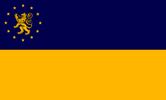Castillia
|
Flag | |
| Motto: Fraternité sous notre Fédération | |
| Capital | Preslaff |
| Largest city | Beziers |
| Official languages | Castillian, Díenstadi |
| Recognised regional languages | Anglic |
| Demonym(s) | Castillian |
| Government | Federated presidential constitutional republic |
• President of the Federation | Marlène Backès |
• Vice-President of the Federation | Maïté Bacque |
• Cassier des Cinqcents (Speaker of the Five-Hundred) | Léo Rousselle |
| Legislature | États-Généraux (States-General) |
| Fédéralsénat (Federal Senate) | |
| Assemblé des Cinqcents (Assembly of Five-Hundred) | |
| Formation | |
• Castillian Unification | 1749 C.E. |
• Federal Unification | 2030 C.E. |
| GDP (PPP) | 2032 estimate |
• Total | $4,010 trillion |
• Per capita | $169,020 |
| HDI (2032) | 0.831 very high |
| Currency | Datary |
| Date format | dd-mm-yyyy CE |
| Driving side | right |
| Calling code | +411 |
| Internet TLD | .cas |
Castillia, officially the Castillian Federation, is a federated presidential constitutional republic located in Greater Díenstad. Comprising the entire Viridian continent, a large island landmass in the Dienstadi orient, it is among the largest countries in the region by square mileage. The country's capital and second-largest city is Preslaff, also the cultural capital of Castillia. Beziers is Castillia's largest city and financial capital, being the headquarters of some of the most prominent financial and corporate entities in Greater Dienstad. Other major urban areas in the country include Ariège, Marais Besançon, Élancourt, Nogent-sur-Marne, and Villeparisis.
Etymology
History
Prehistory
The earliest known estimate of Homo Erectus settling what is known as the Viridian Isle occurred around 1.8 million years ago, presumably crossing an ice bridge from a now-submerged continent. Controlled use of fire is estimated to have started around 800,000 years ago, with modern humans Homo Sapiens appearing on the Viridian Isle around 200,000 years ago. Spreading along the coastline, they often clashed with Erectus and completely wiped out the species 195,000 years ago. The most significant advent of the Upper Paleolithic was agriculture, developed by Sapiens on the Viridian continent around the 9th millennium BC. Evidence proving this was found in an archealogical dig near Vensel in the Province of Le Bouscat. By the 5th millennium the wheel had been invented on Viridia, whether that and the concept of agriculture was the first to be discovered in Viridia is unknown and highly contested. Within 2900 BC literate cuneiform has been developed as well as proto-latin, a tongue attributed as being the forebearer to Romance Latin. This ends the Neolithic era late in 3200 BCE and begins the Bronze Age in Viridia, where the development of sturdy tools, formidable weapons, and economy-based civilizations flourish on the continent. This is also noted as the end of the Neolithic for three reasons: (i) the collapse of the Hexatopolic supercontinent due to the eruption of a supervolcano designated "Dominus Priebe", (ii) the subsequent ash cloud that covered the northern area of Greater Dienstad for at least one year, killing 42% of the Sapiens population, and (iii) rise in sea levels covering any existence of the Hexatopolic continent. These events were marked by the first recorded events of history in Viridia. It was treated by many civilizations as an apocalyptic end-time event, however human society flourished after the event, as well as formed significant pantheons.
Early Civilization
The Acevivate Kingdom is established around 3219 BCE, the first known major society and civilization to establish themselves in Viridia. They become rivaled by the Gaelic peoples who establish loosely-confederated farming states in present-day Castleclose. These neighboring states span from the northern tip of Castleclose to Ulster. To the south in what is the original borders of the Castillian state, several city-states vie for power as they are overlooked by the growing Balochians and their wealthy merchant-based economy. Iron Age states such as the Balochians developed mercantile cultures, the concept of barter and currency, and developed military strategy, as evidenced in the Battle of Brivstasvl against the Maecaynites, which was the first recorded battle between civilizations in the Viridian continent. The Balochians victory against the Maecay people at Brivstasvl led to conjunction of the first organized empire. The Balochian people had subsequently liquidated the Maecaynites and either sold them into slavery or killed them outright. The destruction of the Maecay was the first recorded conquest of another person in Viridia, and the Balochians further flourished as they conquered city-states like Helsindi, Gast, Melatia, and Videmal. The most prominent of rulers of the Balochians, Bathkyr, or Bathkyr the Great, led campaigns as far north as the Chaleur Mountains, where inexperience in fighting in cold elements as well as lack of familiarity of terrain led to defeat at the hands of the tribal bands in those areas, such as the Kepti. Retreating over thousands of miles through the brutal winter, pursued by the Kepti and Vegtik tribes back to Balochia, Bathkyr found his empire in disarray as Melatia and Gast had rebelled and the incredible distance he had went to the Chaleur mountains had given him lack of communication with his court back home. With the Kepti and Vegtik warrior closing in on Becik, the capital, and Gast mounting a large army, Bathkyr committed suicide and thus ended the Balochians as they were submitted into slavery by several different tribes and peoples. Becik was razed and sacked by the Kepti, and left to ruin. Becik lies near the modern-day city of Beziers, and some ruins still stand, such as the Temple of Bacidalus.
